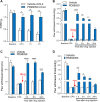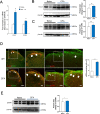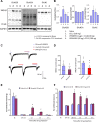Spinal CCL2 Promotes Pain Sensitization by Rapid Enhancement of NMDA-Induced Currents Through the ERK-GluN2B Pathway in Mouse Lamina II Neurons
- PMID: 32809188
- PMCID: PMC7674543
- DOI: 10.1007/s12264-020-00557-9
Spinal CCL2 Promotes Pain Sensitization by Rapid Enhancement of NMDA-Induced Currents Through the ERK-GluN2B Pathway in Mouse Lamina II Neurons
Abstract
Previous studies have shown that CCL2 (C-C motif chemokine ligand 2) induces chronic pain, but the exact mechanisms are still unknown. Here, we established models to explore the potential mechanisms. Behavioral experiments revealed that an antagonist of extracellular signal-regulated kinase (ERK) inhibited not only CCL2-induced inflammatory pain, but also pain responses induced by complete Freund's adjuvant. We posed the question of the intracellular signaling cascade involved. Subsequent experiments showed that CCL2 up-regulated the expression of phosphorylated ERK (pERK) and N-methyl D-aspartate receptor [NMDAR] subtype 2B (GluN2B); meanwhile, antagonists of CCR2 and ERK effectively reversed these phenomena. Whole-cell patch-clamp recordings revealed that CCL2 enhanced the NMDAR-induced currents via activating the pERK pathway, which was blocked by antagonists of GluN2B and ERK. In summary, we demonstrate that CCL2 directly interacts with CCR2 to enhance NMDAR-induced currents, eventually leading to inflammatory pain mainly through the CCL2-CCR2-pERK-GluN2B pathway.
Keywords: C-C motif chemokine ligand 2; Extracellular signal-regulated kinase; Monocyte chemoattractant protein 1; Neuron-glial interaction.
Conflict of interest statement
The authors claim that there are no conflicts of interest.
Figures








Similar articles
-
CCL2 Potentiates Inflammation Pain and Related Anxiety-Like Behavior Through NMDA Signaling in Anterior Cingulate Cortex.Mol Neurobiol. 2024 Aug;61(8):4976-4991. doi: 10.1007/s12035-023-03881-z. Epub 2023 Dec 29. Mol Neurobiol. 2024. PMID: 38157119
-
Spinal CCL2 Promotes Central Sensitization, Long-Term Potentiation, and Inflammatory Pain via CCR2: Further Insights into Molecular, Synaptic, and Cellular Mechanisms.Neurosci Bull. 2018 Feb;34(1):13-21. doi: 10.1007/s12264-017-0106-5. Epub 2017 Mar 6. Neurosci Bull. 2018. PMID: 28265898 Free PMC article.
-
Interferon-gamma potentiates NMDA receptor signaling in spinal dorsal horn neurons via microglia-neuron interaction.Mol Pain. 2016 Apr 18;12:1744806916644927. doi: 10.1177/1744806916644927. Print 2016. Mol Pain. 2016. PMID: 27094552 Free PMC article.
-
Activation of glycine site and GluN2B subunit of NMDA receptors is necessary for ERK/CREB signaling cascade in rostral anterior cingulate cortex in rats: implications for affective pain.Neurosci Bull. 2012 Feb;28(1):77-87. doi: 10.1007/s12264-012-1060-x. Neurosci Bull. 2012. PMID: 22233892 Free PMC article.
-
CCL2-CCR2 Axis Potentiates NMDA Receptor Signaling to Aggravate Neuropathic Pain Induced by Brachial Plexus Avulsion.Neuroscience. 2020 Jan 15;425:29-38. doi: 10.1016/j.neuroscience.2019.11.012. Epub 2019 Dec 2. Neuroscience. 2020. PMID: 31805255
Cited by
-
CCL2 Potentiates Inflammation Pain and Related Anxiety-Like Behavior Through NMDA Signaling in Anterior Cingulate Cortex.Mol Neurobiol. 2024 Aug;61(8):4976-4991. doi: 10.1007/s12035-023-03881-z. Epub 2023 Dec 29. Mol Neurobiol. 2024. PMID: 38157119
-
Effects of Natural Product-Derived Compounds on Inflammatory Pain via Regulation of Microglial Activation.Pharmaceuticals (Basel). 2023 Jun 29;16(7):941. doi: 10.3390/ph16070941. Pharmaceuticals (Basel). 2023. PMID: 37513853 Free PMC article. Review.
-
CCL2 facilitates spinal synaptic transmission and pain via interaction with presynaptic CCR2 in spinal nociceptor terminals.Mol Brain. 2020 Nov 23;13(1):161. doi: 10.1186/s13041-020-00701-6. Mol Brain. 2020. PMID: 33228784 Free PMC article.
-
Mechanistic insights into the role of the chemokine CCL2/CCR2 axis in dorsal root ganglia to peripheral inflammation and pain hypersensitivity.J Neuroinflammation. 2021 Mar 23;18(1):79. doi: 10.1186/s12974-021-02125-y. J Neuroinflammation. 2021. PMID: 33757529 Free PMC article.
-
Magnolin Inhibits Paclitaxel-Induced Cold Allodynia and ERK1/2 Activation in Mice.Plants (Basel). 2023 Jun 12;12(12):2283. doi: 10.3390/plants12122283. Plants (Basel). 2023. PMID: 37375908 Free PMC article.
References
-
- Kiguchi N, Kobayashi Y, Kishioka S. Chemokines and cytokines in neuroinflammation leading to neuropathic pain. Curr Opin Pharmacol. 2012;12:55–61. - PubMed
MeSH terms
Substances
LinkOut - more resources
Full Text Sources
Medical
Molecular Biology Databases
Research Materials
Miscellaneous

